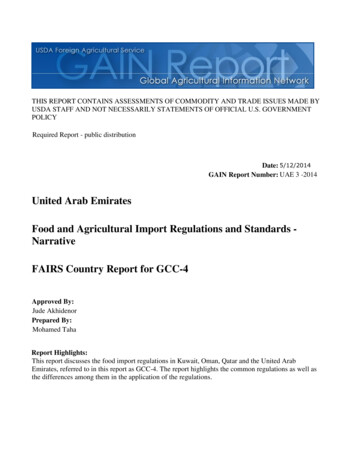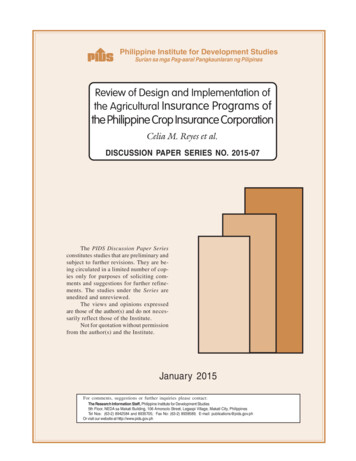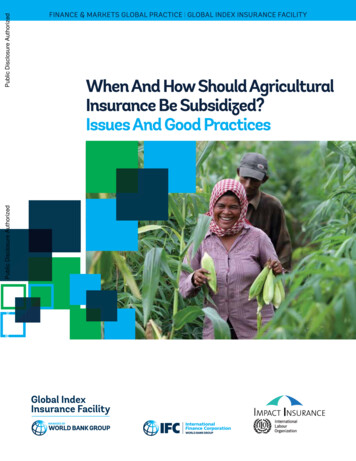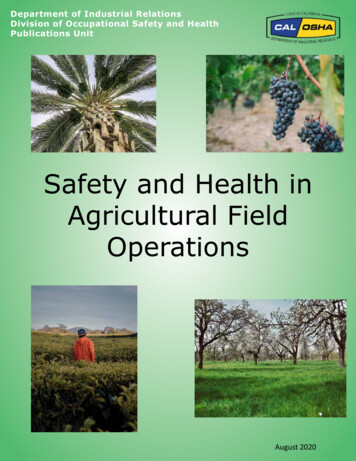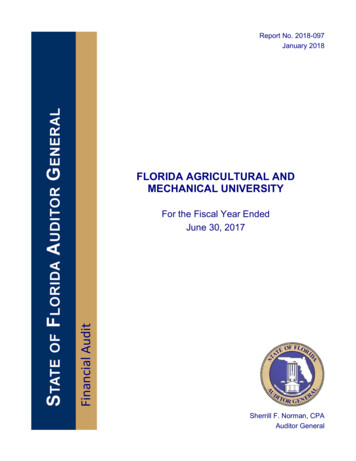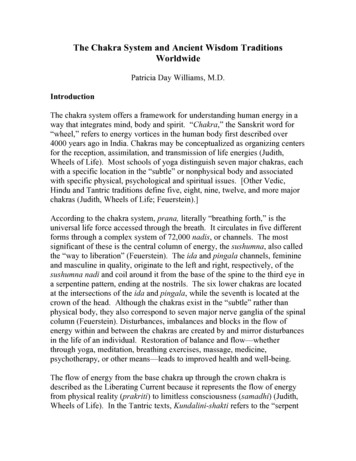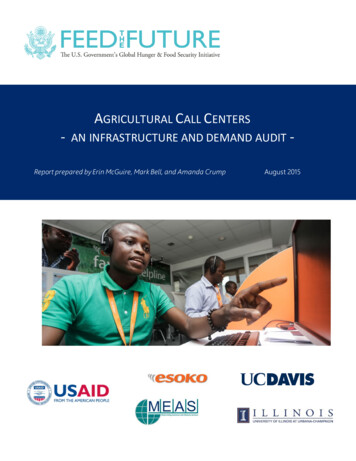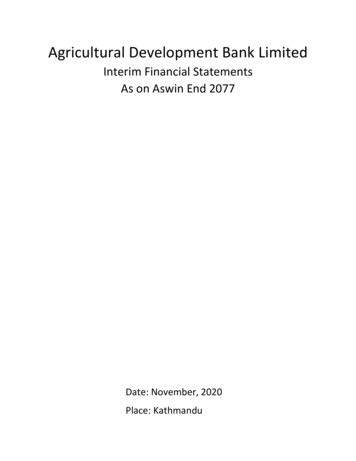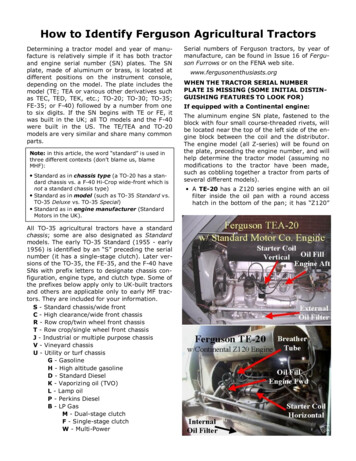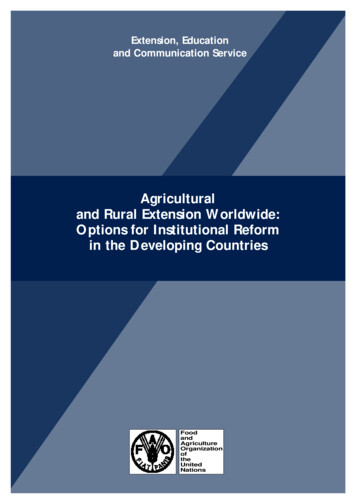
Transcription
Extension, Educationand Communication ServiceAgriculturaland Rural Extension Worldwide:Options for Institutional Reformin the Developing Nations
Agriculturaland Rural Extension Worldwide:Options for Institutional Reformin the Developing CountriesPrepared byWilliam M. RiveraUniversity of Maryland, College Parkin collaboration withM. Kalim Qamar and L. Van CrowderExtension, Education and Communication Service,Research, Extension and Training DivisionSustainable Development DepartmentFOOD AND AGRICULTURE ORGANIZATION OF THE UNITED NATIONSRome, November 2001
The designations employed and the presentation of materialin this information product do not imply the expression of anyopinion whatsoever on the part of the Food and AgricultureOrganization of the United Nations concerning the legal statusof any country, territory, city or area or of its authorities, or concerning the delimitation of its frontiers or boundaries.All rights reserved. Reproduction and dissemination of material in thisinformation product for educational or other non-commercial purposes areauthorized without any prior written permission from the copyright holdersprovided the source is fully acknowledged. Reproduction of material in thisinformation product for resale or other commercial purposes is prohibitedwithout written permission of the copyright holders. Applications for suchpermission should be addressed to the Chief, Publishing and MultimediaService, Information Division, FAO, Viale delle Terme di Caracalla, 00100Rome, Italy or by e-mail to copyright@fao.org FAO 2001
AcknowledgementsThe author wishes to acknowledge the contribution of the many officials at FAOHeadquarters who were interviewed during the period 5 April-25 May 2001 forthe development of this paper on «Agricultural and rural extension worldwide:Options for institutional reform in the developing countries».The assignment could not have been completed without the invitation and indepth assistance of the officials in SDRE (Extension, Education andCommunication Service): Ester Zulberti, Chief; M. Kalim Qamar, AgriculturalExtension and Training; Abdullah Gaaya, Agricultural Extension and Training;Loy Van Crowder, Communication for Development; Jean-Pierre Ilboudo,Communication for Development; Mario Acunzo, Communication forDevelopment; L. Gasperini, Agricultural Education; Jacques Jallade, AgriculturalEducation; P. Lacki, Agricultural Education and Extension; and William Seiders,Rural Youth.Officials at SDRR (Research and Technology Development Service) were alsohelpful in understanding the role of this important unit, especially AbubakerMaddur and John Stenhouse.Other FAO officials engaged in extension and extension-related activities provided the author with a broad view of the various services within the FAO, viz.,Andrew MacMillan, Investment Centre (TCI); Richard China, Investment Centre(TCI); François Dauphin, Investment Centre (TCIE); Guy Evers, InvestmentCentre (TCIR); Kevin Gallagher, Plant Protection Service (AGPP); Doyle Baker,Farm Management and Production Economics Service (AGSP); John Dixon,Farm Management and Production Economics Service (AGSP); Yeb Hiemstra,Field Operation Division, SPFS Coordination and Monitoring Branch (TCOS);Ronald Maine, Fishing Technology Service (FIIT); Jan Johnson, FishingTechnology Service (FIIT); Katharine Warner, Forestry Policy and InstitutionsBranch (FONP); Hiroyuki Tanaka, Forestry Policy and Institutions Branch(FONP); Florence Egal, Nutrition Programmes Service (ESNP); John Rouse,Rural Institutions and Participation Service (SDAR); James Bingen, AgriculturalSupport Systems Division (AGS); (seconded from U. of Michigan); StephenRudgard, World Agricultural Information Centre (WAICENT); Simon Mack,Animal Production Service (AGAP); and John Hourihan, Women inDevelopment Service (SDWW).Others who have contributed to the author’s development of the paper includeDenis Lucey, Consultant to OECD, Gary Alex, Consultant to World Bank, andKerry J. Byrnes, USDA Economic Integration and Free Trade Advisor, USAIDBureau for Latin America and the Caribbean.iii
AcronymsAASADASAKIS/ ricultural Advisory ServiceAgricultural Development Advisory ServiceAgricultural Knowledge Information System for RuralDevelopmentAgricultural Knowledge SystemAgricultural Knowledge TriangleCompagnie française pour le développement des fibres textiles(French-run Textile Development Company)Food and Agriculture Organization of the United NationsFee-charging extensionFarmer Field SchoolsFarmers’ Forest Management SchoolsFarming Systems DevelopmentFarming Systems ResearchInformation and Communications TechnologyIntegrated Support to Sustainable Development and FoodSecurityNational Agricultural Advisory ServiceNational Agricultural Extension Systems Reform InitiativeNon-Governmental OrganizationsOrganization of Economic Cooperation and DevelopmentExtension, Education and Communication ServiceResearch and Technology Development ServiceSocio-economic and Gender AnalysisStrategic Extension CampaignSpecial Programme for Food SecuritySyndicat des Producteurs de Coton de VivriersInvestment CentreTraining and Visit Extension Management SystemVirtual Extension and Research Communication NetworkWorld Agricultural Information Centrev
Table of ContentsAcknowledgementsAcronymsPrefacePurpose and rationaleiiiv131.Agricultural and rural extension: definitions1.1 Extension: a function1.2 Agricultural extension: a knowledge system1.3 Agricultural and rural extension: an expanded concept1.4 Alternative extension approaches1.5 Government’s role in agricultural and rural extension reform777911122.Global developments shaping extension2.1 The new paradigm2.2 Responding to the new paradigm1516173.FAO’s current programmes for agricultural and rural extension3.1 Multiple extension approaches and purposes19194.Institutional reform: a new vision for agriculturaland rural extension development4.1 The contemporary institutional reform of extension4.2 Market reforms4.3 Non-market reforms4.4 A dynamic view of extension institutional reforms4.5 Vision and guiding principles for extension development2324252830315.Reform initiatives5.1 From pluralism to partnership5.2 Partnerships with farmers and the private sector5.3 Cost recovery schemes5.4 Decentralization to lower tiers of government5.5 Subsidiarity (decentralization) to the grassroots level333436363738Concluding remarks39References41FiguresFigure 1: Extension as a function in various sectors of societyFigure 2: Agricultural extension as part of AKS/AKISFigure 3: Extension reform strategiesFigure 4: A dynamic view of extension institutional reforms782430vii
Preface1The Food and Agriculture Organization of the United Nations (FAO) contributesconsiderably to the advancement of agricultural and rural extension as evidencedby its worldwide conferences, information exchanges, field programmes and projects.There are, however, certain global developments that demand a fresh vision if theagricultural and rural extension institutions in the developing countries are to berevitalized and made more effective and efficient. This vision encompasses institutional reforms towards both market-oriented privatizing innovations and nonmarket decentralizing reforms, and constitutes the backdrop against which a newvision can be applied.This paper reviews and draws on a broad range of existing reform options, andon the basis of this review proposes a number of initiatives for institutionalreform in the developing countries. These strategies are intended to help FAOstaff to provide guidance to the developing countries for the reform of their agricultural and rural extension systems.The paper begins with definitions that distinguish between (a) extension as afunction, (b) agricultural extension as part of a larger knowledge triangle, and (c)agricultural and rural extension as an expanded concept of knowledge and information systems. In many low-income developing countries, agricultural andrural extension is in disarray, which bodes ill for countries that should nowaccommodate the new paradigm which is increasingly being shaped by globaltrends towards market-driven and highly competitive agribusiness enterprises.Indeed, these trends highlight the tension that exists between the modern force ofglobalization and the traditional forces of culture, geography, and community(Friedman 2000).The initiatives proposed in this paper draw on recent agricultural extensionreform measures introduced in several high-income, middle-income and lowincome countries. The focus, however, is on reform measures that promote foodsecurity and poverty alleviation among small-holders in low-income countries.The initiatives are broadly envisaged as applications of the principles set out inthe FAO/World Bank document on Strategic Vision and Guiding Principles (2000)for promoting Agricultural Knowledge and Information Systems for RuralDevelopment (AKIS/RD), and other frameworks emphasizing the changingextension environment (Neuchâtel 1999).1 This paper adopts a broad rural focus as opposed to a narrow agricultural focus, in line withthe rural development strategy for reducing poverty and eliminating hunger adopted in theWorld Bank’s paper on Rural Development: From Vision to Action (1997) and the FAO/WorldBank’s paper Agricultural Knowledge and Information Systems for Rural Development:Strategic Vision and Guiding Principles (2000).1
The AKIS/RD vision calls for institutional reforms involving pluralism, costrecovery, privatization, decentralization and subsidiarity, with an emphasis onparticipatory approaches. These reforms constitute the main menu of options discussed in this paper. They include both market and non-market reforms. TheFAO Extension, Education and Communication Service (SDRE) has begunexploring these initiatives to reform extension in the Philippines, Iran, Zimbabwe,Nigeria, Pakistan, Indonesia, Eritrea, Mozambique, Uganda, Yemen, and othercountries, some of them in collaboration with the FAO Investment CentreDivision (TCI) and the World Bank. The results of these efforts highlight the interest of policymakers in the developing countries to pursue extension institutionalreform.Ester ZulbertiChiefExension, Education and Communication Service2
Purpose and rationaleThis paper outlines three agricultural and rural extension market reforms and twonon-marketing reforms, at all times emphasizing stakeholder, and particularlyend-user, participation in the approaches employed in these reforms. It also recognizes the need for non-farm microenterprise development initiatives, andadvocates coordinating this effort with other international organizations. Thepaper recommends that FAO should explore these and related institutionalreform options with the developing countries, as an important means of assistingthem to revitalize their agricultural and rural extension systems.In the present climate of change, poverty alleviation and food security are majorconcerns to FAO and its member states. This was evidenced at the 1996 WorldFood Summit, at which the representatives of FAO member countries pledgedtheir dedication to alleviating poverty using every means available. Agriculturaland rural extension is one of the means available to help alleviate poverty andimprove food security. It promotes the transfer and exchange of information thatcan be converted into functional knowledge, which is instrumental in helping todevelop enterprises that promote productivity and generate income.In addition to technology transfer, agricultural and rural extension is a uniqueservice in that it provides access by small farmers and the rural poor living farfrom the urban centres to non-formal education and information services. Whileit can provide these populations with services to increase their productivity, theirfood security will depend on institutional development and income-generation,together with increased food crop output. Studies of food security and malnutrition (Von Braun 1993) have concluded that the primary cause of malnutrition inthe less developed countries is not the scarcity of food so much as distributionproblems, and the existence of poverty. In a major report on world agriculture,the World Bank stated: «.in the long run, people can attain food security only ifthey have adequate income.»On the subject of productivity, FAO’s Director-General notes that «farm output bysmall farmers in low-income food-deficit countries is feasible (often using quitesimple and low-cost technologies) and can, under most circumstances, achieve thecombined objectives of improving rural livelihoods, increasing food supplies within rural communities, having a multiplier effect on economic growth, and reducingforeign exchange expenditure on food imports» (FAO 2001). Similar assumptionsunderlie the Sustainable Livelihoods Approach espoused by the UK’s Departmentfor International Development, the Sasakawa Global-2000 programme and the SoilFertility Initiative. It is becoming increasingly more evident that the long-term solution to world hunger lies in “helping the poor to produce more and better-qualitystaple food more efficiently in order to take the first step out of poverty” (Diouf3
2000). This implies the need to raise farm productivity per unit of input, improvethe competitiveness of food marketing systems (so that local producers have incentives to raise productivity when faced by the reality or prospect of cheaper foodimports), and raise the incomes of the poor throughout the developing world.Certainly, if farmers are to increase production, adequate attention needs to be paidto helping them keep their production costs per unit competitive with prevailingmarket prices, which are notoriously fickle (FAO 1987).Yet, as the FAO’s The State of Food and Agriculture 2000 concludes:Reducing poverty and food insecurity is not simply a question of enhancing agricultural productivity and production or of generating more income. Institutionsare the structuring features that command access of people to assets, to voice andto power over their lives and that regulate competing claims to limited resources.It is fundamental to address those institutional, governance and politico-economic factors that tend to exclude individuals and population groups from progress.Perhaps it goes without saying that extension as an institution is only one component in agricultural and rural development processes, and that it is only onevehicle for fostering change in agricultural and rural development. Yet the importance of knowledge and the rapidity of its transfer and exchange in the modernworld are increasingly recognized as central to trade and development, in highincome as well as in low-income countries (Drucker 1998; Zijp 1994). Extension’shigh economic rates of return indicate its potential to bring about change(Birkhaeuser, Evenson & Feder 1988). The world has entered a new economic system that has evolved from «structural adjustment» and trade liberalization, andalso from technological progress and advances in telecommunications and greaterinterdependence of the world labour, product, and financial markets. Whileknowledge and capital are becoming increasingly more central to achieving success in this new economic system, some countries have yet to consider the valueof making knowledge available through revived extension services. The pressures of the new economy may soon induce these countries to re-examine theirextension institutions and their extension institutional arrangements with a viewto reforming and revitalizing them.The extension reforms being adopted worldwide offer new ways of viewing andaddressing the issue of agricultural and rural development.Change today is global and rapid. A new paradigm has emerged towards a market-driven, agribusiness orientation, stressing comparative advantage in a highlycompetitive global market. This globalization and market orientation is placingnew pressures on governments and their people to produce more, for bothdomestic consumption and trade.At the same time, the developing countries have implemented structural adjustments that have made them reduce public spending on services. But the international organizations are nevertheless urging the developing countries to fostereducational activities and enhance their human capital. The commitment topoverty alleviation and food security is an expression of that concern, especiallyfor rural areas remote from the urban centres.Although learning via agricultural extension services is only one component ofthe complex process of development, studies suggest that this process produces4
high economic rates of return (Birkhaeuser, Evenson, & Feder 1988). Few woulddeny that work-related functional knowledge is central to economic success. Inthe present context of change, one of the challenges facing FAO is how to promotethe economic success of the countries that represent the billion or so people wholack the functional knowledge which agricultural and rural extension can help toprovide.5
1. Agricultural and rural extension:definitions1.1 Extension: a functionExtension, in general terms, is a function that can be applied to various areas ofsociety. It operates in the industrial, health and education sectors, as well as agricultural and rural development. Originally derived from «university extension»(Mosher 1976), the term «extension» is therefore applicable to various areas ofdevelopment.Figure 1: Extension as a function in various sectors of xtensionServicesIndustrialExtensionAs Figure 1 illustrates, extension functions in various sectors of society. In earlierdiscussions on the World Bank-sponsored Training and Visit (T&V) extension system, Israel (1982) stressed the fact that T&V principles could be applied to othersectoral systems involved in the delivery of nonformal education. It also warned,however, that T&V was based on classical management principles that wereunlikely to be viable in the developing countries - a lesson that was only fullyappreciated in the 1990s and that has since led in part to the current emphasis onparticipatory management principles.1.2 Agricultural extension: a knowledge systemAgricultural extension operates within a broader knowledge system that includesresearch and agricultural education. FAO and the World Bank refer to this largersystem as AKIS/RD (Agricultural Knowledge and Information Systems for RuralDevelopment). The OECD countries refer to it simply as the AgriculturalKnowledge System (AKS). Others describe the three pillars of this system –research, extension and agricultural higher education – as «the agriculturalknowledge triangle» and suggest that since the three pillars involve complementary investments they should be planned and sequenced as a system rather thanas separate entities (Eicher 2001). Linking the triangle’s institutions with theircommon clientèle, namely the farmers, and with each other, also requires systematic planning.7
At the second OECD AKS conference in January 2001, the representatives of agricultural research, education and extension institutions, and government officialswith AKS policy responsibilities stressed the opportunities for AKS to address thewider societal issues associated with agriculture. The participants confirmed thatAKS could play a central role in developing research, education andextension/development programmes oriented towards these wider society issues,which can be expected to expand (OECD 2001). In this scenario, the planning andsequencing of AKS as a single system, as Eicher (2001) suggests, becomes even moreimperative. However, much has been
by its worldwide conferences, information exchanges, field programmes and pro - jects. There are, however, certain global developments that demand a fresh vision if the agricultural and rural extension institutions in the developing countries are to be revitalized and made mor
